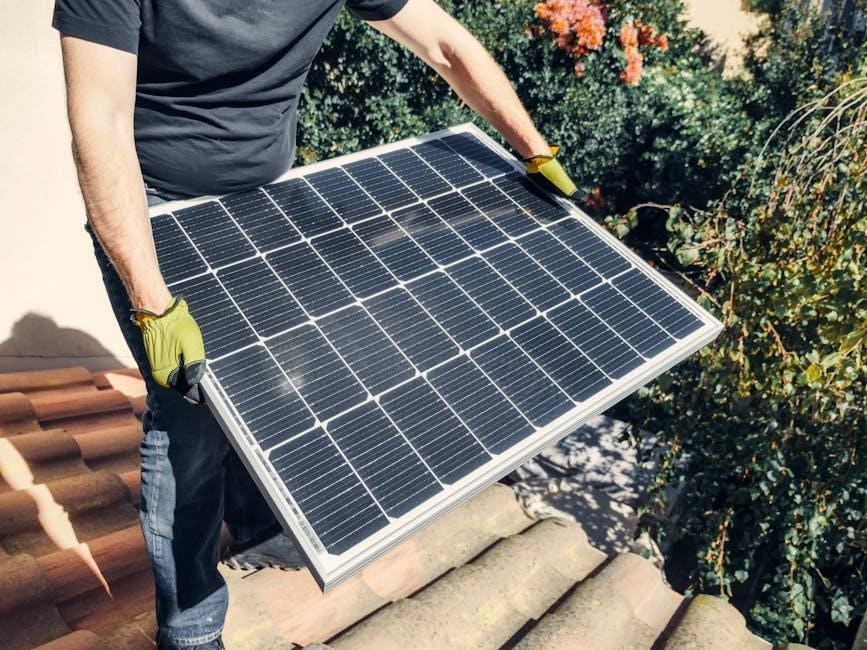Welcome to the Honeywell 6000 Installation Manual, your comprehensive guide to installing, configuring, and troubleshooting the Honeywell 6000 thermostat. This detailed manual is designed for both professional installers and homeowners, providing step-by-step instructions to ensure proper setup and operation. It covers essential topics like system compatibility, wiring, and advanced features, helping you maximize the potential of your Honeywell 6000 thermostat for efficient HVAC system control.
Overview of the Honeywell 6000 Thermostat
The Honeywell 6000 thermostat is a programmable, Wi-Fi-enabled device designed for efficient temperature control in residential and commercial settings. It features a high-resolution touchscreen interface, geofencing capabilities, and voice control compatibility with smart home systems. The thermostat supports multiple heating and cooling stages, including emergency heat and auxiliary settings, ensuring precise climate management. With its advanced energy-saving features, it helps reduce energy consumption while maintaining comfort. The Honeywell 6000 is compatible with a wide range of HVAC systems and integrates seamlessly with Honeywell zoning panels for enhanced system performance. Its user-friendly design and robust functionality make it a versatile solution for modern HVAC needs.

System Requirements and Compatibility
The Honeywell 6000 thermostat is compatible with most HVAC systems, including gas, oil, electric, and heat pump configurations. It supports up to 3 heating and 2 cooling stages, requiring a 24V AC power supply and a C-wire connection. Ensure your system matches these requirements for proper installation and operation.
Compatible HVAC Systems and Tools Needed
The Honeywell 6000 thermostat is compatible with a wide range of HVAC systems, including forced air, heat pumps, and radiant floor heating. It supports multi-stage systems, up to three heating stages and two cooling stages. For installation, you will need basic tools such as a screwdriver, wire strippers, and a voltage tester. Ensure your system has a 24V AC power supply and a C-wire connection. Additional tools like a drill and wall anchors may be required for mounting. Compatibility also extends to various Honeywell zoning panels, allowing for seamless integration with existing home automation setups. Always verify system specifications before proceeding with installation to ensure optimal performance and safety.

Installation Process
The Honeywell 6000 thermostat installation involves pre-installation checks, removing the old thermostat, mounting the new device, connecting wires, and testing the system to ensure proper functionality.
Pre-Installation Steps
Before installing the Honeywell 6000 thermostat, ensure the system is turned off at the circuit breaker. Remove the wallplate from the old thermostat and carefully pull the wires through the wire hole. Position the new wallplate according to the mounting instructions provided. If your system includes a furnace, verify that the furnace door is securely closed. For battery-powered models, install fresh AA alkaline batteries as instructed on page 17. Remove the battery holder before proceeding with the installation. Follow the mounting directions for a new installation to ensure proper alignment and secure fitting. These steps ensure a safe and efficient installation process.
Mounting and Wiring Instructions
To mount the Honeywell 6000 thermostat, first remove the wallplate from the old thermostat and gently pull the wires through the wire hole; Position the new wallplate according to the mounting instructions, ensuring proper alignment. For wiring, carefully connect each wire to the corresponding terminal on the thermostat, following the color-coded guide or the wiring diagram provided in the manual. Secure all connections firmly to avoid loose wires. After wiring, test the system to ensure proper functionality. If replacing an old thermostat, verify that all wires are compatible and properly routed. Refer to the appendix for detailed wiring diagrams and terminal labels. These steps ensure a secure and correct installation of the Honeywell 6000 thermostat.
Configuration and Setup
After installation, configure the Honeywell 6000 thermostat by accessing the installer setup menu. Follow on-screen instructions to select system type and preferences, ensuring proper functionality and efficiency.
Initial Thermostat Configuration
Start by powering on the Honeywell 6000 thermostat and navigating to the setup menu. Select your preferred language and unit of measurement. Set the date and time accurately for scheduling. Choose between heating, cooling, or automatic mode based on your system type. Configure temperature ranges, ensuring they align with your comfort preferences and system capabilities. Enable features like smart recovery or geofencing if supported. Save your settings to complete the initial configuration, ensuring the thermostat operates efficiently and meets your HVAC needs. If unsure, refer to the manual for detailed guidance on each step to avoid errors. Proper setup ensures optimal performance and energy efficiency.
Wiring Configuration and System Testing
After mounting the thermostat, carefully connect the wires according to the wiring diagram provided in the manual. Ensure all connections are secure to avoid malfunctions. Once wired, power on the system and proceed to test each function. Verify heating, cooling, and fan operations to confirm proper connectivity. Check for auxiliary heat and emergency heat settings if applicable. Test the thermostat’s ability to switch modes seamlessly. If using smart features, ensure Wi-Fi connectivity is established and the device is linked to your smart home system. Perform a full system cycle to identify any issues. If errors occur, consult the troubleshooting section or verify wiring connections. Proper testing ensures the thermostat and HVAC system operate efficiently and safely, delivering consistent comfort and energy savings. Always follow safety guidelines during testing to prevent damage or hazards.

Advanced Features and Settings
The Honeywell 6000 thermostat offers advanced features like programmable scheduling, energy-saving modes, and smart home integration. These settings optimize comfort and energy efficiency, guided by the manual’s instructions.
Emergency Heat and Auxiliary Settings
The Honeywell 6000 thermostat includes emergency heat and auxiliary settings to ensure reliable operation during system failures or extreme conditions. Emergency heat activates when the primary heating system fails, while auxiliary settings provide backup options. To configure these, install a field jumper between the Aux and E terminals if no emergency heat relay is present. Follow the manual’s wiring instructions carefully to avoid system damage. Always test emergency heat and auxiliary functions after installation to confirm proper operation. These features enhance system reliability and user safety, ensuring consistent comfort even in critical situations. Refer to the manual for detailed configuration steps and safety precautions to avoid equipment damage or improper functionality.
Wi-Fi and Smart Home Integration
The Honeywell 6000 thermostat supports seamless Wi-Fi and smart home integration, allowing users to control their HVAC system remotely through the Honeywell Home app. To enable this feature, ensure the thermostat is connected to your home Wi-Fi network during the initial setup. Once connected, you can access advanced features like scheduling, geofencing, and energy usage tracking directly from your smartphone. Additionally, the Honeywell 6000 is compatible with popular smart home platforms, enabling voice control through Amazon Alexa or Google Assistant. For optimal performance, ensure your router is within range and the thermostat’s firmware is up-to-date. This integration enhances convenience and energy efficiency, providing a modern, connected home experience. Follow the manual’s instructions for a smooth setup and enjoy remote monitoring and adjustments anytime, anywhere.

Troubleshooting Common Issues
Address common issues like faulty wiring, power outages, or sensor malfunctions. Check connections, ensure proper power supply, and test system functions. Refer to the manual for detailed solutions and diagnostic steps to resolve installation or operational problems effectively.
Diagnosing and Resolving Installation Problems
Diagnosing and resolving installation issues with the Honeywell 6000 thermostat requires a systematic approach. Start by verifying all connections are secure and match the wiring diagram. Check for proper power supply and ensure the thermostat is correctly mounted. If the display is blank, confirm batteries are installed correctly or that the system has power. For heating or cooling issues, test the emergency heat and auxiliary settings. Review the installation manual for specific error codes and follow the troubleshooting guide. Consult the wiring configuration section to ensure all connections align with your HVAC system. Testing each function step-by-step can help identify and resolve problems efficiently, ensuring optimal performance.
